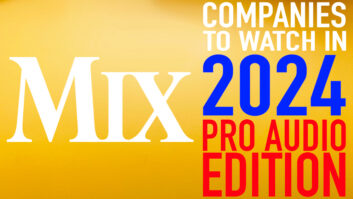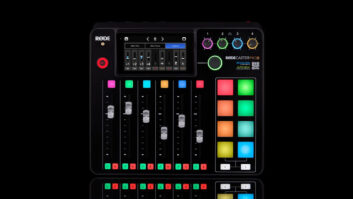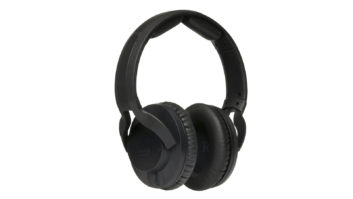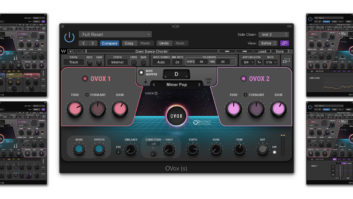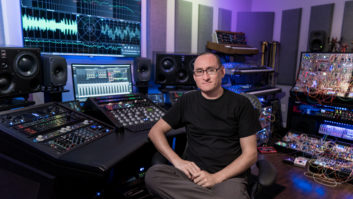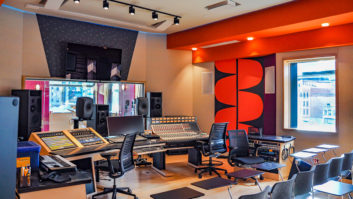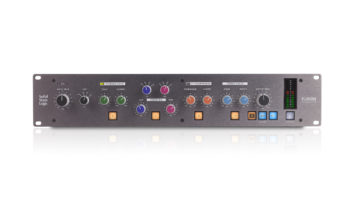
The Aphex Channel combines the company’s Aural Exciter and Big Bottom into a single-rackspace recording channel.
Aphex has made a name for itself with its unique brands of processors, preamps, converters, instrument pedals and accessories. Whether helping a particular element poke through the fog of a dense mix, or adding extra luster to an entire mix, patented processes like the Aural Exciter and Big Bottom are welcome additions to any signal flow. The Aphex Channel reviewed here features a fixed signal flow including up to seven different signal processors. It also has a good number of inputs and outputs, both analog and digital, making it a DAW-friendly front end.
Getting Connected
The Channel features strictly analog input, with only one available at any time. A microphone can be connected to the rear panel using a balanced XLR connector, or this input is bypassed when an instrument is connected to the ¼-inch TS input on the front panel. Neither input is designed to accept a line-level signal, but users can purpose the 0dBu balanced insertion point between the dynamics processor and the equalizer section for line-level inputs. This provides access to the tone processors, skipping the compressor, gate and de-esser.
The output connections provide something for everyone. Balanced output at +4 dBu feeds either an XLR connector, or a ¼-inch TRS connector, and the ¼-inch can be switched to -10 dBV for unbalanced operation. Digital output is available through an XLR connector for AES/EBU, or S/PDIF can pass through an RCA type connector or optical TOSLINK connector. Sample rate and clock source selections are done on the front panel with visual feedback from an illuminated display. When synching to external word clock, the Channel automatically sets up the A/D converter accordingly.
If there is a next generation, I would like to see a dedicated unprocessed line-level input to the second channel of the A/D; a similar feature is found on Focusrite’s ISA One or Universal Audio’s 4-710d. With that, you could chain together two Channels and feed them through one digital pipeline into a 2-channel digital interface.
Rack in the Box
The Aphex-patented RPA Preamp kicks it off at the input stage. This hybrid circuit features a solid-state front end and a tube-based back end, and is designed for a wide dynamic range and lower noise floor than a typical tube preamp. In a shootout against the Universal Audio Twin-Finity 710 the Channel’s character was similar, but the Channel seemed to push a bit more bottom end, even with all processors bypassed. This was very apparent when recording an acoustic guitar, although the 710 had better top-end detail. For voice-over, on the other hand, the Channel gave the track a big broadcast-style sound.
The mic preamp provides toggle buttons for a 75Hz highpass filter, -20 dB pad, polarity-invert switch, 48-volt phantom power, and a unique “phase rotator.” While the name suggests something akin to the Little Labs IBP, that is not really the case at all. This circuit is more closely related to classic FM radio processors designed to correct problems related to asymmetrical waveforms. We’ve all seen waveforms wherein the top is taller than the bottom, or vice versa. When the shorter portion ends up being positive, a compressor may fail to respond correctly. The phase rotator cues the compressor’s threshold to trigger based on the positive and negative peaks in order to improve its response. Listening and visually analyzing waveforms recorded into a DAW, it was hard to predict the outcome. Depending on the nature of the voice, mic and proximity, sometimes the Channel produced the desired effect, and sometimes it didn’t seem to do much at all. However, when it was audible, is was a nice added bonus.
After the preamp comes the Easyrider compressor, whose attack, threshold and gain reduction all automatically adjust relative to the nature of the input signal. In other words: Driving the preamp harder results in more gain reduction, prior to an automatic make-up gain. When recording speech in a post-production session, it was easy to dial in a great sound with either a smooth natural character or hard compressed sound. When recording a bass, I found it challenging to find the right sound. After much tweaking, I would find a good sound, but seemed to clip the A/D converter too often. Compromising would mean a sound that is overly compressed, too thin, or unable to cut through the mix. While I was eventually able to muster up a pleasant sound for bass, the process wasn’t nearly as intuitive as my experience with speech. It seems that the preset attack and knee are geared more toward vocals than other instruments.
Next comes the Logic-Assisted Gate, which is designed to work with the compressor and inhibit the compressor’s release when the gate is trying to close. This clever design produced very useful results, and I was really impressed on all sources. The response was very natural, especially when allowing a small amount of room tone to pass through by setting the Depth control a little shy of the maximum attenuation setting. The gate’s attack and release characteristics felt more universally suited to both voice and instruments than those found in the compressor. A Release control would have come in handy in a few instances, but it was still one of the most versatile gates I’ve used.
The de-esser worked very well and was musical and transparent. As I started cranking the single knob that controls the effect, I was second-guessing whether it was bypassed; the overall sound is very transparent.

Sculpting Tones
The last section before the output gain control is the tone-shaping section—which features the Big Bottom circuit—and a single-band, midrange-frequency parametric EQ, followed by the Aural Exciter. Given the fact that the Aural Exciter is designed to create artificial upper harmonics, the common misconception of the Big Bottom is that it is a sub-harmonic generator, but it is not. Instead, it is a circuit that separates existing bass frequencies and compresses them, which adds weight and sustain, and then selectively adds them back into the signal. When recording voice-over or ADR, I was able to clean up the sound using HPF, the gate, and then the Big Bottom, creating something like a selective proximity effect. Even with a distant shotgun mic, I was able to pull the sound forward or push it back into the scene. Creating the ultimate announcer’s voice was a snap using a close mic and adding some Big Bottom. It was important not to overdo it, because sometimes the bass would sustain beyond the rest of the voice, sounding unnatural.
The single band of parametric EQ sounds good but limits your options. When recording voice, and even more so when recording acoustic guitar, I missed the option of bumping upper midrange while scooping the low-mids. I tried addressing the low-mids with the EQ and hitting the highs with the Aural Exciter, but it wound up just sounding grainy and artificial. It was easier to get this right when recording voice. I found that by boosting upper-mids with the EQ and adding the Big Bottom and Aural Exciter, I was able to effectively punch a hole in the low-mids and get the vocal sound I wanted.
Is It Your Everything?
My experience with the Aphex Channel was positive, especially when recording voice. Using the combination of processors to sculpt a usable tone from any vocal subject couldn’t have been more convenient and pleasant. With the compressor and gate holding the voice steady in a comfortable dynamic range, and a few tweaks of the output control, I was able to quickly park the voice at a steady -23 LKFS referencing a meter compliant with ITU-BS.1770-2. I never had a chance to use the Channel to record hip-hop vocals, but this processing chain would have been perfect for that, too.
Getting so much processing in a small box and in a fixed order sometimes compromises the Channel’s ability to be the perfect box for every situation. For instance, getting the perfect electric bass sound took some experimenting, but certainly this device is capable of producing some unique bass tones. The Aphex Channel’s design makes it better at some uses than others. If you are looking for an “it” vocal chain to add to your setup, I would certainly recommend this one.
Brandon Hickey is a freelance engineer and audio educator.
TRY THIS
With tube pre’s like the Channel, even someone who is inexperienced in modifying electronic circuits can try out some different flavors by simply swapping out the tube, which isn’t recommended by the manufacturer. Pulling a socketed tube and replacing it requires no soldering, and is easily reversed. I swapped the stock (unlabeled) 12AT7 for a Groove Tubes 12AT7, and found slightly less noise and a bit of improved detail in the top end. For use as a bass DI, popping in a high-gain 12AX7 might provide a little extra grind.
PRODUCT SUMMARY
COMPANY: Aphex
PRODUCT: Channel
WEBSITE:aphex.com
PRICE: $999 street
PROS: Easy to sculpt great vocal sounds.
CONS: Fixed-order processors make some workflows difficult.
